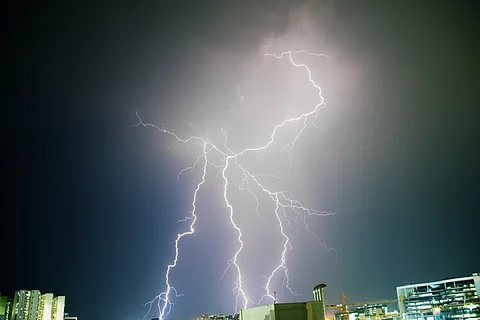

At least 162 people were killed by lightning strikes across 12 Indian states between March 2025 and April 17, 2025 — a staggering 184 per cent rise compared with 57 fatalities recorded last year between March 2024 and April 2024. An analysis of data from the Extreme Weather Events Atlas by the Centre for Science and Environment and Down to Earth (DTE), along with publicly available data from disaster management authorities, shows that this has been the deadliest March–April period for lightning since 2022.
The first 17 days of April 2025 alone accounted for 142 deaths, a fivefold increase over April 2024, which saw just 28 lightning fatalities. Comparing just the month of March, lightning strikes claimed 20 lives this year, down from 29 recorded in 2024.
Experts attributed the surge to atmospheric instability driven by moist easterly winds from the Bay of Bengal, but argued that many of the deaths were avoidable with better preparedness and public awareness.
Bihar was the worst-affected state, recording 99 lightning deaths between March and mid-April 2025 — 61 per cent of the national total. Shockingly, 98 of these deaths occurred within just six days, from April 9-14, according to the state’s disaster management authorities.
This made April 2025 the deadliest month for lightning in Bihar since 2017. Previous highs were 25 deaths in April 2020, 24 in 2018, and 12 in 2019. The state reported zero lightning-related fatalities during March and April in both 2023 and 2024.
Bihar has long been one of India’s most lightning-prone states and a hotspot for related deaths and injuries. Between 2014 and 2024, it ranked second nationally in lightning-related deaths, as per the Annual Lightning Report 2023-24 by the Climate Resilient Observing Systems Promotion Council (CROPC).
Most fatalities typically occurred during the monsoon season, particularly in June and July. A study published in the Journal of Earth System Science found that between 2017 and 2022, June and July accounted for 58.8 per cent of lightning deaths and 59.4 per cent of injuries in the state. The early onset of fatal strikes in April 2025, therefore, marked a notable shift in the usual pattern.
In just 17 days, the month marked a nine-year high, according to month-wise data from a state-level study and the CSE-DTE extreme weather database.
Previously, the highest number of lightning-related deaths in April was recorded in 2020, with 25 fatalities, followed by 24 in April 2018 and 12 in April 2019. In contrast, April 2021 and April 2022 saw only two such deaths each. Notably, in both 2023 and 2024, the state reported zero lightning-related fatalities during March and April.
Uttar Pradesh followed with at least 28 deaths, 23 of which occurred in the first 17 days of April. This represented a 460 per cent increase compared to the five deaths recorded between March and April 2024. All five of those fatalities occurred in March, with none in April last year.
These lightning strikes are driven by environmental conditions, but the resulting loss of human life could have been avoided.
The lightning outbreaks were linked to unstable weather triggered by humid easterly winds moving from the Bay of Bengal towards the Himalayan foothills and parts of neighbouring Uttar Pradesh, where they met western disturbances and jet stream, Colonel Sanjay Kumar Srivastava, founder of CROPC, told DTE. CROPC developed India’s first Lightning Early Warning System, Earthquake Early Warning System and Cyclone Risk Management System.
This convergence intensified convective activity, creating ideal conditions for thunderstorms and lightning. As per a media report, India Meteorological Department officials reported a shift in wind direction — from southwest to northeast — which often signals the approach of severe, localised storms. These conditions are known to trigger strong winds, thunderstorms and lightning.
Srivastava noted that lightning, while a natural phenomenon, need not lead to such high human tolls — awareness and timely action can save lives. “There is also a serious lack of awareness about lightning safety precautions, as evidenced by 23 deaths in Nalanda, where people had taken shelter under a tree and a dilapidated temple,” he said.
The deadly event had been forecast three to four days in advance. Yet, state and district disaster management authorities failed to act swiftly, he stated. “Early warning requires early action. In this case, the lead time wasn’t utilised, and poor rural communities were caught off guard,” Srivastava said.
While the mobile app SACHET had been developed to alert the public to imminent hazards, Srivastava said many villagers ignored the warnings. He also criticised the lack of a robust communication and action plan for responding to early warnings, claiming that existing dissemination protocol issued by the National Disaster Management Authority were not followed.
“It is time these states (Bihar and Uttar Pradesh) overhauled their disaster management capabilities and drew lessons from the experiences of states like Odisha,” Srivastava stated